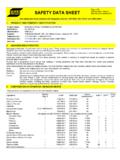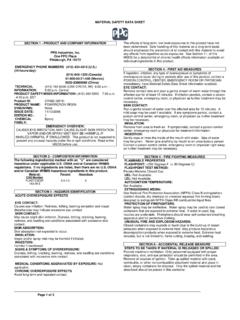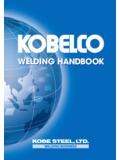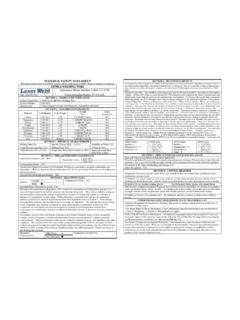Transcription of MATERIAL SAFETY DATA SHEET Spilfyter ... - Spill Kit
1 Section 1. Chemical product and company identification product Number: 5200 Series product Name: MERCSORB Mercury Amalgamation Powder Manufacturer: Emergency Telephone Numbers: NPS Corporation CHEMTREC--Domestic (800)424-9300 24 hours 3303 Spirit Way --International (202)483-7616 24 hours Green Bay, WI 54304 Information (800) 558-5066 7:30am-4:30pm CDT M-F Section 2. Composition/Information on Ingredients CAS Registry # Component 7440-66-6 Zinc Dust 77-92-9 Citric Acid (NOTE: See Section 8 of this MSDS for Exposure Guidelines) Section 3. Hazards identification Emergency Overview Odorless, very fine, blue, gray, or white powder. *Conact from welding,grinding or open flame may cause zinc dust to burn. Contact with acids oralkaline may evolve hydrogen gas. Potential Health Effects Eye: May cause irritation. Skin: May cause irritation. Repeated skin contact may aggravate an existing dermatitis (skin condition) and/or sensitivity of the skin.
2 Inhalation: Exposure to dust levels exceeding the PEL (see Section 8) may irritate the nose, throat, and upper respiratory system. Signs and Symptoms: Eyes: Redness, Tearing, Possible burns Skin: Redness, Swelling, Possible burns Inhalation: Discomfort of the nose and throat, headache, fever, chills, muscle aches, nausea, and tiredness. These symptoms may persist for 6 to 24 hours. Section 4. First Aid Measures Eyes: Immediately flush with plenty of water for at least 15 minutes. If irritation persists, seek medical attention. Skin: Remove contaminated clothing. Brush off excess powder with a dry towel. Wash affected area with plenty of soap and water for several minutes. If skin irritation develops or persists, seek medical attention. Inhalation: Remove to fresh air. If not breathing, give artificial respiration. If breathing is difficult, give oxygen. Seek medical attention. Ingestion: If swallowed, call a physician or poison control center immediately.
3 Mercury Sorbent Powder Section 5. Fire Fighting Measures MATERIAL SAFETY DATA SHEET Spilfyter Products Economy Mercury Spill KitPage 1 Revision Date: 03/10/2014 Flash Point: Not Tested Flammable Limits: Lower Explosive Limit (LEL): g/ft3 Upper Explosive Limit: NA Auto-ignition Temperature: NA Extinguishing Media: Rock dust or dry sand Special Fire Fighting Procedures: For large fires or fires in confined areas, full emergency equipment with self-contained breathing apparatus and full protective clothing should be used. Dry zinc dust will not ignite spontaneously, but once ingnited, it may burn readily in air. Thermal decomposition of this product may produce carbon monoxide and carbon dioxide. Section 6. Accidental Release Measures Avoid breathing or generating airborne dust. Avoid contact with skin and eyes. If unused MATERIAL is spilled, collect by sweeping, shoveling or vacuuming and recycle the MATERIAL for use . If this product is mixed with other materials, see Section 13.
4 Section 7. Handling and Storage Store in a cool, dry, and well ventilated area. Keep container tightly closed. Avoid contact with materials listed in Section 10. Keep away from flammable materials and sources of heat or flame. Section 8. Exposure Controls/Personal Protection Exposure Limits: None specifically established for this product ; treat as a nuisance dust as defined in 29 CFR OSHA PEL: Total Zinc Dust is 15 mg/M3. Respirable Fraction, Zinc Dust, is 5mg/M3. ACGIH TLV is 10mg/M3. The end-user must determine the specific types of personal protective equipment needed according to 29 CFR Personal Protective Equipment (PPE) for General Industry. The following are only suggestions: Eyes: SAFETY glasses or goggles Skin: Suitable chemically resistant gloves and protective clothing Inhalation: Air purifying respirator with appropriate chemical cartridge or canister Adequate ventilation should be provided to limit the threat of inhalation.
5 Section 9. Physical and Chemical Properties Appearance: Very fine blue, gray, or white powder Odor: Odorless Evaporation Rate (Butyl Acetate=1): NA Boiling Point: 1666 F % Vaporizable by volume (H2O=100): NA Vapor Pressure (mmHg): NA Vapor Density: NA Solubility in Water: Very lightly soluable Specific Gravity (H2O=1): Melting Point: 787 F pH: 1% aqueous solution MATERIAL SAFETY DATA SHEET Spilfyter Products Economy Mercury Spill KitPage 2 Revision Date: 03/10/2014 Section 10. Stability and Reactivity Stable: May react Conditions to Avoid: Wet AluminumIncompatibility (Materials to Avoid): Liquid acids and bases, cyanides, sulfides, and hypochlorites. Hazardous Decomposition or Byproducts: Thermal decomposition of this MATERIAL may produce carbon monoxide and carbon dioxide. Hazardous Polymerization: Will not occur Section 11. Toxicological Information This product is not listed by NTP or IARC.
6 See Section 15. Section 12. Ecological Information No data available. See Section 15. Section 13. Disposal Considerations This product in itself is considered to be non-hazardous as defined by RCRA (40 CFR 261). Once used, this product may take on the characteristics of the chemical(s) it was used with and should be disposed of accordingly. Disposal of this product (used or unused) must be in compliance with all local, state, and federal regulations. Section 14. Transport Information DOT: This product is not a DOT hazardous MATERIAL and is not regulated for all shipping purposes. Section 15. Regulatory Information This product was laboratory tested to determine classification for transportation according to (flammable solids) (self heating substances) (substances which on contact with water emit flammable gasses) against the following regulations: 1) Transportation of Dangerous Goods Act and Regulations (Canada) 3) International Marine Dangerous Goods Regulation 4) Dangerous Goods Regulations 1995 International Air Transport Association (IATA) Flammable Solids Division 2) Code of Federal Regulation, Transportation, Chapter 49, Parts 100 to 177, Revised as of Oct.
7 1, 1992, Part 173, Appendix E Test results confirm that this product DID NOT MEET THE CRITERIA FOR INCLUSION INTO CLASS , AND PACKAGING GROUP I, II OR III. TSCA Inventory Status: All components are listed on the TSCA list. SARA Title III Section 302 Extreme Hazardous Substance List: Not listed Section 311/312 Hazard Classification: Immediate (acute): Yes Delayed (chronic): Yes Fire: No Sudden Release of Pressure: No Mercury Sorbent Powder Regulatory Information (cont): Reactive: No Section 313 Toxic Chemicals: Listed Zinc Powder or Dust 1% USEPA CERCLA Reportable Quantity (RQ): Not listed RCRA Hazardous Waste: Not listed MATERIAL SAFETY DATA SHEET Spilfyter Products Economy Mercury Spill KitPage 3 Revision Date: 03/10/2014 State/Int l Right-to-Know Regulations: Canada s WHMIS Citric Acid 1% Section 16. Other Information Abbreviations: CFR: Code of Federal Regulations OSHA: Occupational SAFETY and Health Administration MSDS: MATERIAL SAFETY Data SHEET PEL: Permissible Exposure Limit NA: Not Applicable ACGIH: American Conference of Governmental Industrial Hygienists TLV: Threshold Limit Value NTP: National Toxicology Program IARC: International Agency for Research on Cancer RCRA: Resource Conservation and Recovery Act TSCA: Toxic Substances Control Act SARA: Superfund Amendments and Reauthorization Act USEPA: United States Environmental Protection Agency CERCLA: Comprehensive Response, Compensation, and Liability Act DOT: Department of Transportation WHMIS: Workplace Hazardous Materials Information System : Not Otherwise Specified NFPA: National Fire Protection Association HMIS: Hazardous MATERIAL Information System NFPA Ratings: HMIS Ratings.
8 Health: 0 Health: 0 Fire: 1 Flammability: 1 Reactivity: 1 Reactivity: 1 Special Hazard: Avoid Water Personal Protection: X NOTE: This MSDS has been prepared only for the Mercury Sorbent Powder (5200 Series) of Spilfyter Products. The MSDS s of the chemicals used with this product must be reviewed completely, and precautions taken as described. The information accumulated herein has been compiled from sources believed to be reliable and is accurate to the best of our knowledge. However, NPS Corporation cannot give guarantees regarding the information from sources, and expressly does not make any warranties, nor assumes any liability for its uses of this product . MATERIAL SAFETY DATA SHEET Spilfyter Products Economy Mercury Spill KitPage 4 Revision Date: 03/10/2014 Section 1. Chemical product and company identification product Number: 4610 Series product Name: Mercury Vapor Suppressor Manufacturer: Emergency Telephone Numbers: NPS Corporation CHEMTREC--Domestic (800)424-9300 24 hours 3303 Spirit Way --International (202)483-7616 24 hours Green Bay, WI 54304 Information (800) 558-5066 7:30am-4:30pm CDT M-F Section 2.
9 Composition/Information on Ingredients CAS Registry # Component 7440-44-0 Activated Carbon 7704-34-9 Sulfur Section 3. Hazards identification Emergency Overview Odorless, black, irregular, dry granular solid. Wet activated carbon removes oxygen from the air causing a severe hazard to workers inside carbon vessels and enclosed or confined spaces. Before entering such an area, sampling and wok procedures for low oxygen levels should be taken to ensure ample oxygen availability, observing all local, state and federal regulations. Potential Health Effects Eye: May cause irritation. Skin: May cause irritation. Repeated skin contact may aggravate an existing dermatitis (skin condition) and/or sensitivity of the skin. Inhalation: Exposure to dust levels exceeding the PEL may cause irritation of the upper respiratory system. Breathing dust may aggravate acute or chronic asthma or other chronic pulmonary diseases. Signs and Symptoms: Eyes: Redness, tearing Skin: Redness, swelling Inhalation: Dry cough Section 4.
10 First Aid Measures Eyes: Immediately flush with plenty of water for at least 15 minutes. If irritation persists, seek medical attention. Skin: Remove contaminated clothing. Wash affected areas with soap and water for several minutes. If skin irritation develops or persists, seek medical attention. Inhalation: Move to fresh air. If breathing is difficult, give oxygen. Seek medical attention if required. MATERIAL SAFETY DATA SHEET Spilfyter Products Economy Mercury Spill KitPage 5 Revision Date: 03/10/2014 Section 5. Fire Fighting Measures Flash Point: NA Flammable Limits: NA Auto-ignition Temperature: 500 F Extinguishing Media: Water spray, dry chemical foam or carbon dioxide. Use water spray or fog to cool exposed equipment. Section 6. Personal Protection Eyes: SAFETY glasses or goggles Skin: Chemically resistant gloves and protective clothing Inhalation: Air purifying respirator with appropriate chemical cartridge or canister Adequate ventilation should be provided Section 7.






